Electric vehicles have the potential to soothe and simplify, to declutter and maximize space. The transition to EVs marks an opportunity for automakers to reinvent the entire vehicle around a distinctive look and feel, with less drama.
Put away any impressions you might have about Nissan’s original mass-market electric car, the Leaf, as the 2023 Nissan Ariya seizes on that opportunity. From profile to design details, interface to switchgear, it bears little resemblance to anything in the Nissan lineup, EV or not.
The look on the outside is clean. Radar sensors hide beneath a blacked-out front fascia, below neat, slim headlamps, which is partly why Nissan couldn’t locate the charging port up front like in the Leaf. The silhouette is unique, and it hits a sweet spot between upright and clean yet curvaceous. Thank the designers profusely that this one keeps the brightwork to a minimum. The matte-copper detailing inside helps conduct it all.
The latest round of EVs all land, almost disconcertingly, in the same overall footprint—within an inch or two of the Volkswagen ID.4 or, for that matter, a Honda CR-V. But they each apportion their space differently. In the Ariya, which Nissan notes packs the space of a Murano in the 183-inch-long footprint of a Rogue, the driving position in front is more elevated than I would have expected from the outside (there’s plenty of space to adjust downward, but you can’t). I’m a long-legged 6-foot-6, and in the lowermost adjustment I was brushing the moonroof surround when I adjusted the seatback to be as upright as I prefer.

2023 Nissan Ariya – preview drive (Euro spec)
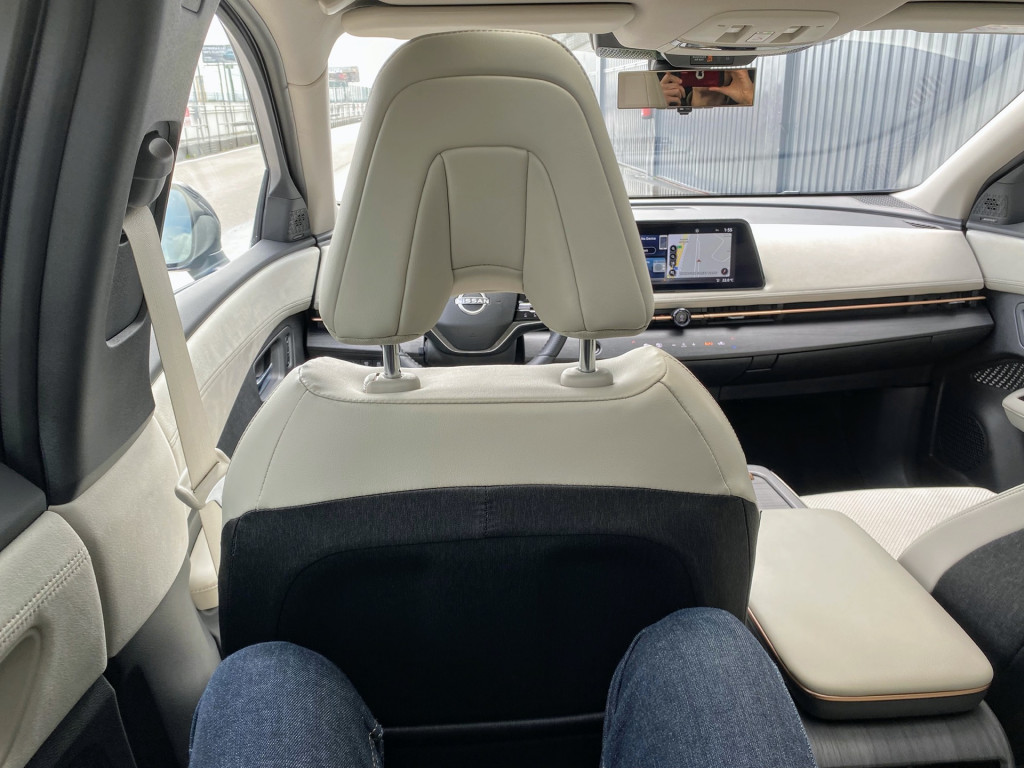
2023 Nissan Ariya – preview drive (Euro spec)
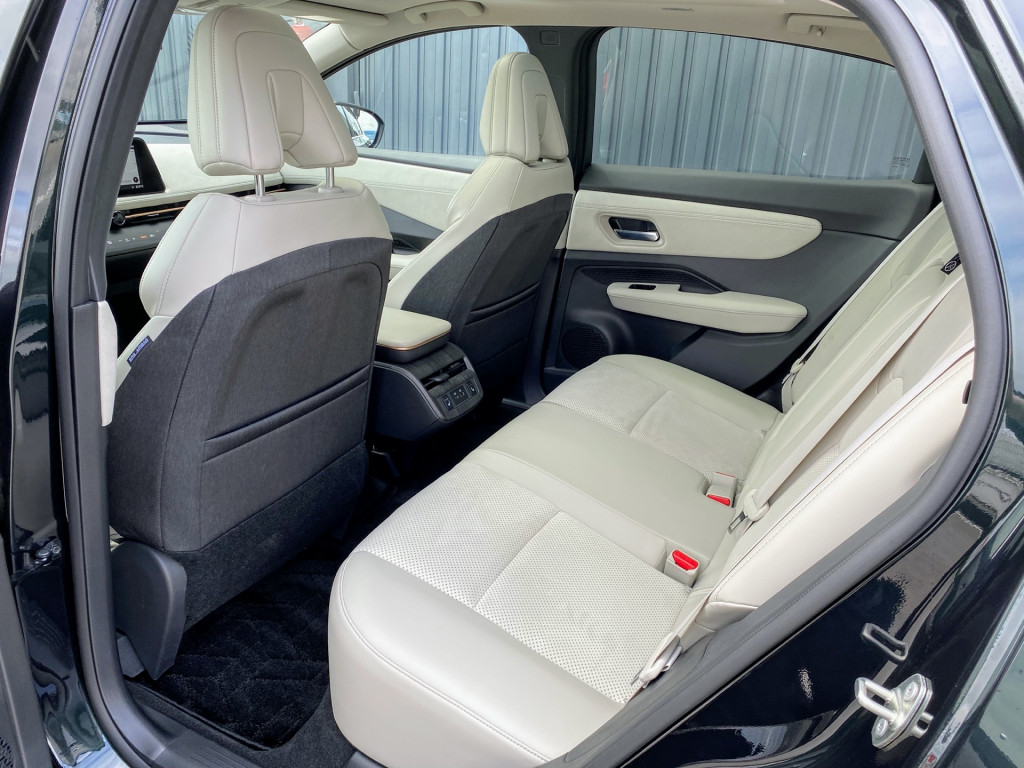
2023 Nissan Ariya – preview drive (Euro spec)
In back, the seats sit lower, and I found it easy to get in and get comfortable. The upper portion of the cabin doesn’t taper like the Ford Mustang Mach-E or Kia EV6, which helps make the back seat feel more spacious, especially for a third person in the middle.
Cargo space is just superb. The rear seats fold flat to expand its 22.8 cubic feet to 59.7 cubic feet, and the cargo area has a dual-layer space afforded by a horizontal shelf you can remove completely if needed. The liftover height is easy and low. This isn’t an off-roader by any means.
By shifting the air conditioning and heating components under the hood, along with other key propulsion components, Nissan freed up cabin space. While that helps enable a vast footwell and a short dash, it eliminates a frunk.

2023 Nissan Ariya – preview drive (Euro spec)
As I found this week, in a very limited preview drive opportunity, the Ariya drives differently than other EV crossovers, too. It combines a settled ride with great body control and a supremely quiet interior that’s going to win over families. The Ariya promises a more comfortable, upright layout than the Mach-E or EV6, and its materials are more distinctive than the Hyundai Ioniq 5. At first look, its interface appears quicker to react and more intuitive than that of the Volkswagen ID.4, but that’s not a high bar to clear.
Starting grid: A lot of choice, starting at $40,000
Ariya buyers will be able to choose from single-motor front-wheel-drive or dual-motor all-wheel-drive versions, both offered with a choice of battery packs—63 kwh or 87 kwh usable capacity—with ranges from about 215 miles up to about 300 miles. Base models with the small pack and single-motor layout will start around $40,000.
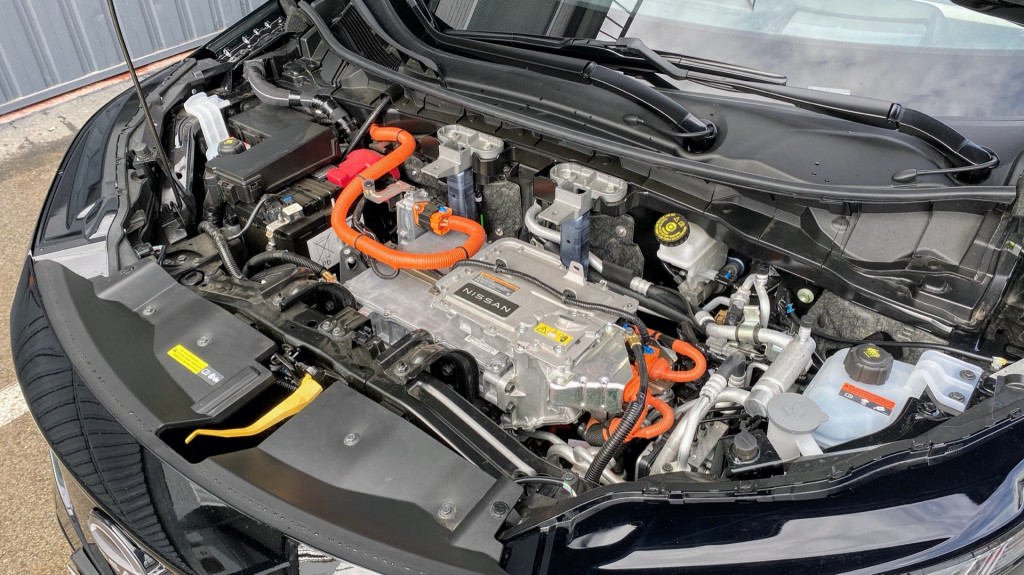
2023 Nissan Ariya – preview drive (Euro spec)
Counterintuitively, Nissan has revealed specs and prices for the higher-spec and dual-motor all-wheel-drive models that will arrive later, while the front-wheel-drive models—with either of the packs—will arrive sooner. For the U.S., that means a late-fall arrival for AWD models versus early fall for FWD versions. Prior to the release of the base versions, which will arrive yet this year, the Ariya starts at $47,125, and the e-4orce AWD version starts at $60,125.
Output numbers vary across all four combinations of motors and battery packs, ranging from 214 hp and 221 lb-ft of torque (base battery, FWD) to 389 hp and 442 lb-ft (large battery, AWD). Performance is right in the middle of the pack for this class of EV, which means it’s quicker than any like-priced gasoline model. Ariya 0-60 mph times will range from about 4.7 seconds in dual-motor, big-battery versions to about 7.2 seconds in single-motor form with the smaller battery.
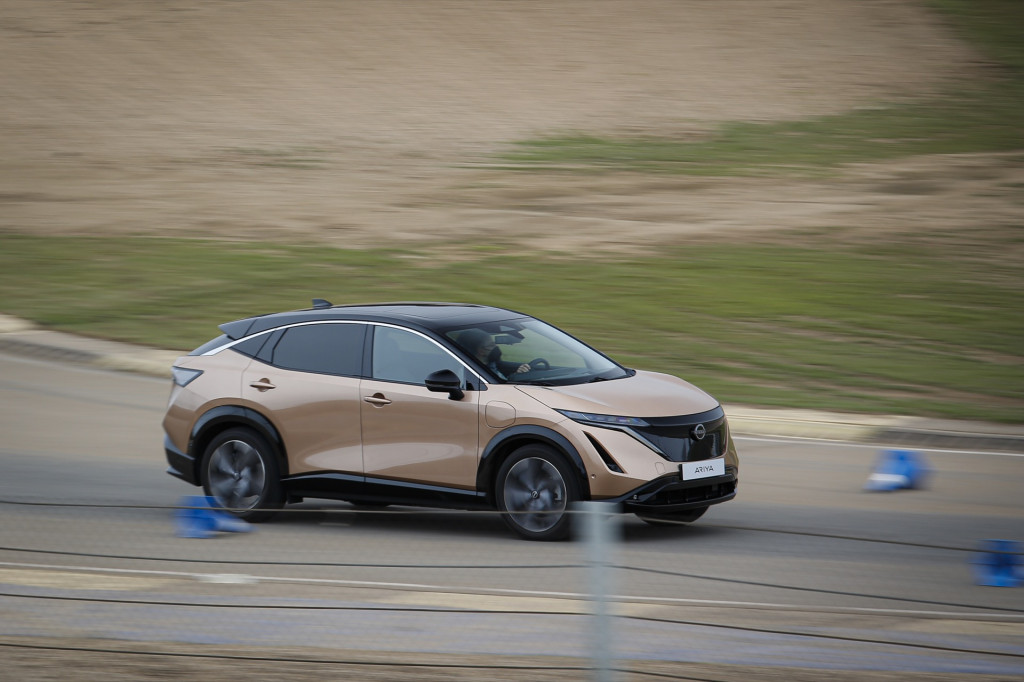
2023 Nissan Ariya – preview drive (Euro spec)
I drove the single-motor, small battery model for less than 30 minutes on a closed course coned off at Madrid’s Circuito de Jarama racetrack to replicate a range of conditions, including tight urban maneuvering, mid-speed lane changes, various types of corners, and the chance to get a bit past 75 mph. Acceleration felt especially strong from 40 to 70 mph—a zone in which some other base, single-motor EVs in this class are less impressive. While it accelerates quicker from 0-60 mph than the Leaf, the flip side is that it doesn’t feel nearly as punchy and torquey off the line.
That’s due mostly to the motor choice. The Ariya’s Externally Excited Synchronous Motor design—the same front and rear, depending on the version—uses fewer rare-earth elements, and it’s more efficient at highway speeds than the Leaf’s permanent magnet design.
Lessons from Leaf, but that’s where the similarities end
From a technical standpoint, the Ariya isn’t an evolution of what underpins the Leaf. Instead it’s a complete rethink. The space-maximizing CMF-EV platform, set to be shared with Infiniti and Renault, forms the basis, and the long 109.3-inch wheelbase, the different motors, and the charge-port location are just a few of many the choices in the Ariya that depart from Leaf convention. These changes only underscore that the Ariya is a clean-slate model reflecting different development priorities and lessons learned from the pioneering Leaf, which will continue to coexist with the Ariya.
In addition, the Ariya is ready for over-the-air updates. Its battery cells are a prismatic format rather than pouch, and they come from a different supplier, CATL. And yes, the battery pack is liquid-cooled.
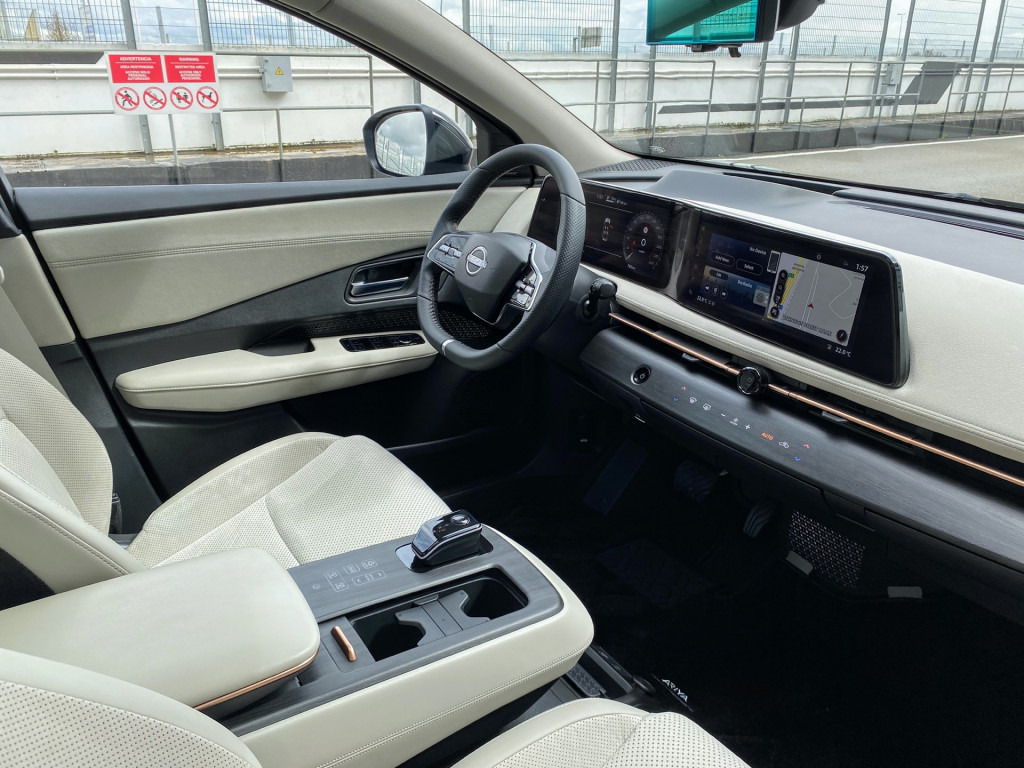
2023 Nissan Ariya – preview drive (Euro spec)
It takes a long look around to spot the few items that carry over. The Leaf’s e-Pedal one-pedal driving mode and its B/D shift modes are a couple of the transplants—although even those are tuned differently to emphasize the Ariya’s next-level comfort and poise. You won’t find paddle-shifters, but between the D (regular) and B (more brake regen) modes, plus e-Pedal—and three different modes that each tune it differently (Standard, Sport, and Eco)—there’s a wide range of responsiveness and reaction you can dial in. The D shift mode offers 0.07 g of regen in Standard, 0.08 in Sport, and 0.03 in Eco (“gliding” like an easygoing automatic gasoline vehicle, essentially), while the B mode locks in a predictable 0.12 g of regen. Click e-Pedal on and that triggers a noticeably more aggressive 0.2 g of regen, which uses the brake pads a bit to keep it predictable.
Just as in the Leaf, e-Pedal affects the feel of the brake pedal, but without it engaged the smoothness of its brake-blending through the pedal is excellent. If you’re driving solo, you’ll find e-Pedal a great driver’s aid for the city; but with any passengers aboard, B is probably the way to go as e-Pedal can cause passengers heads to bob when it engages.
Versus the Leaf, Nissan allows the Ariya to “creep” up to 7 mph in e-Pedal mode when you lift off the brake pedal, which should aid drivability in parking lots or when a rolling stop is expected.
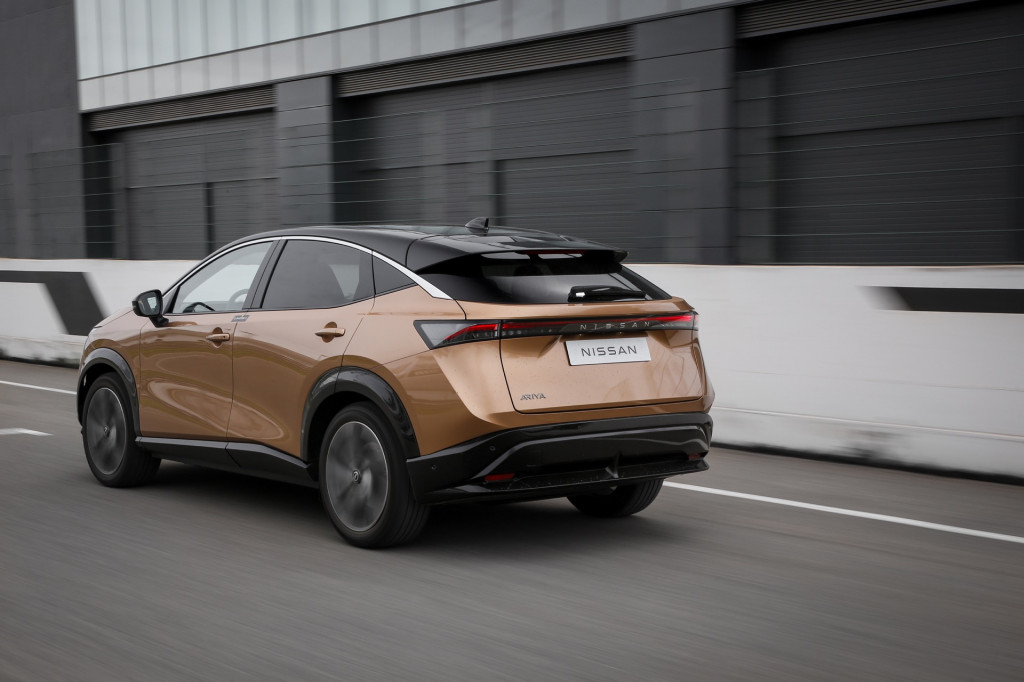
2023 Nissan Ariya – preview drive (Euro spec)
As for keeping the passengers happy, e-4orce all-wheel-drive models boast a feature that should really help distinguish the Ariya in the market. Drawing from dynamic sensor and software expertise from Nissan’s all-wheel-drive GT-R supercar, e-4orce uses ultra-quick torque adjustments between the dual motors to adjust the fore-and-aft attitude of the car during strong acceleration, braking, or cornering. That helps the vehicle feel flatter in any of those transitions, even in ordinary e-Pedal driving. Although I haven’t felt this demonstrated in an Ariya (AWD models will go into production a few months later), Nissan has previewed this wizardry in a development mule, and I found it works.
Sporty but not harsh
Nissan says the Ariya’s suspension is optimized for stability and comfort while suppressing vibrations, and that description is right on the mark from what I observed—although the track’s surface was just too perfect to comment much on ride quality. With a near 50/50 weight distribution in either version of the vehicle, the front-drive version I drove didn’t feel overly nose-heavy and without any of the e-4orce controls it still felt surprisingly nimble in tight corners. In U.S. spec, as driven, the Ariya weighs about 4,300 pounds. That’s right on par with the base Ioniq 5, and likely to be close to the forthcoming base-battery ID.4.
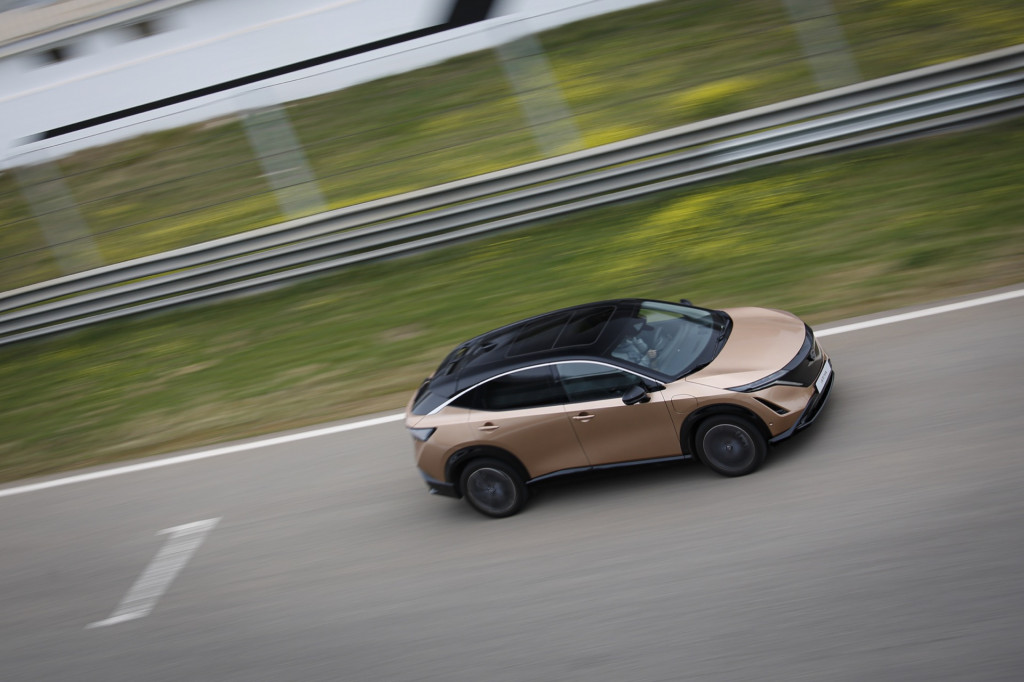
2023 Nissan Ariya – preview drive (Euro spec)
The steering is an unexpected delight, tracking well on center but well-weighted and even a bit communicative. Sport mode drops the assist by about 20% without making it feel artificially heavy.
A sweet spot between buttons and simplicity
There’s a lot to love about the interior design and control interface, which offer warm tones, pattern inspiration from Japanese woodcarving, nods to traditional lanterns in the ambient lighting, pleasantly grained dash and console surfaces; and haptic buttons that work without latency (side eye to the ID.4). The buttons you need to look down for are clearly outlined with boundaries, and they flick back with a satisfying prompt click. The volume knob in the middle of the center stack has a sturdy feel, too. Overall, it’s a simple look, without tech overload, and no key switchgear is missing

2023 Nissan Ariya – preview drive (Euro spec)
The Ariya also provides plenty of opportunities for passengers to get comfortable. My well-equipped test car included a power slide-out tray that extends back from the dash and is flexible and sturdy enough to hold a few pounds. It can be used as a picnic table or a laptop stand. The Ariya also has a power-adjustable center console that slides fore and aft allowing it to be used as an armrest or to give those in back some convenience or extra space.
One gripe: Nissan has once again redesigned the shifter. Instead of the Leaf’s Toyota Prius-like shifter, you essentially slide a puck fore and aft, with a side button press required for reverse and a separate button for Park. It feels unnecessary and awkward.
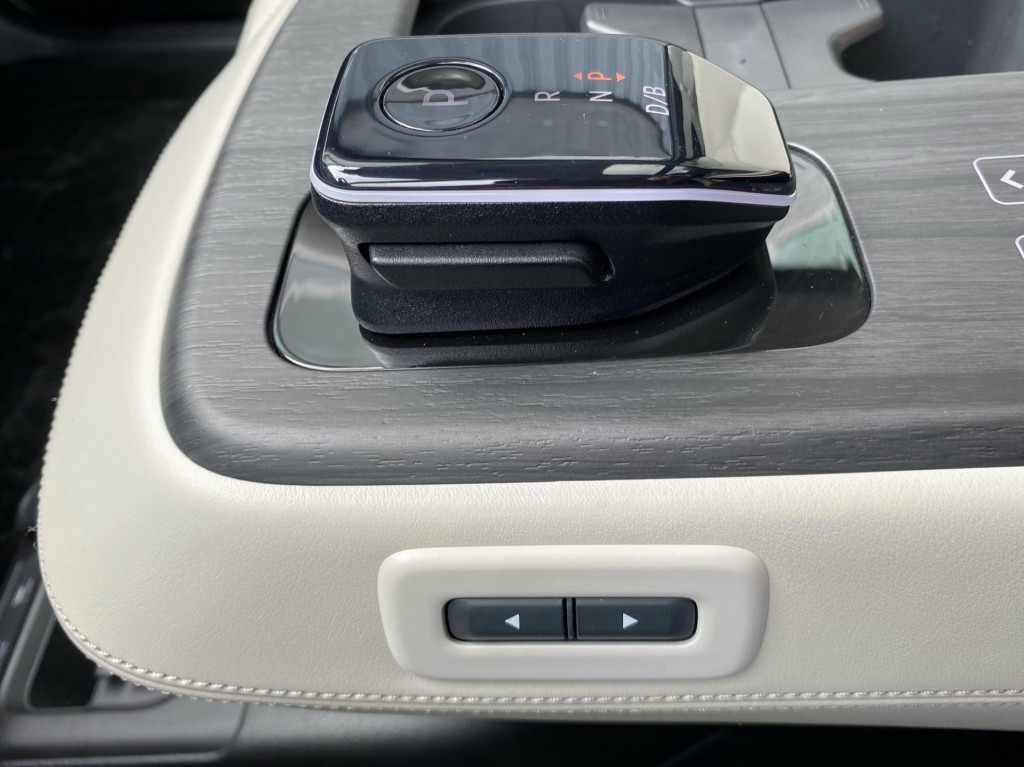
2023 Nissan Ariya (Euro spec) – preview drive
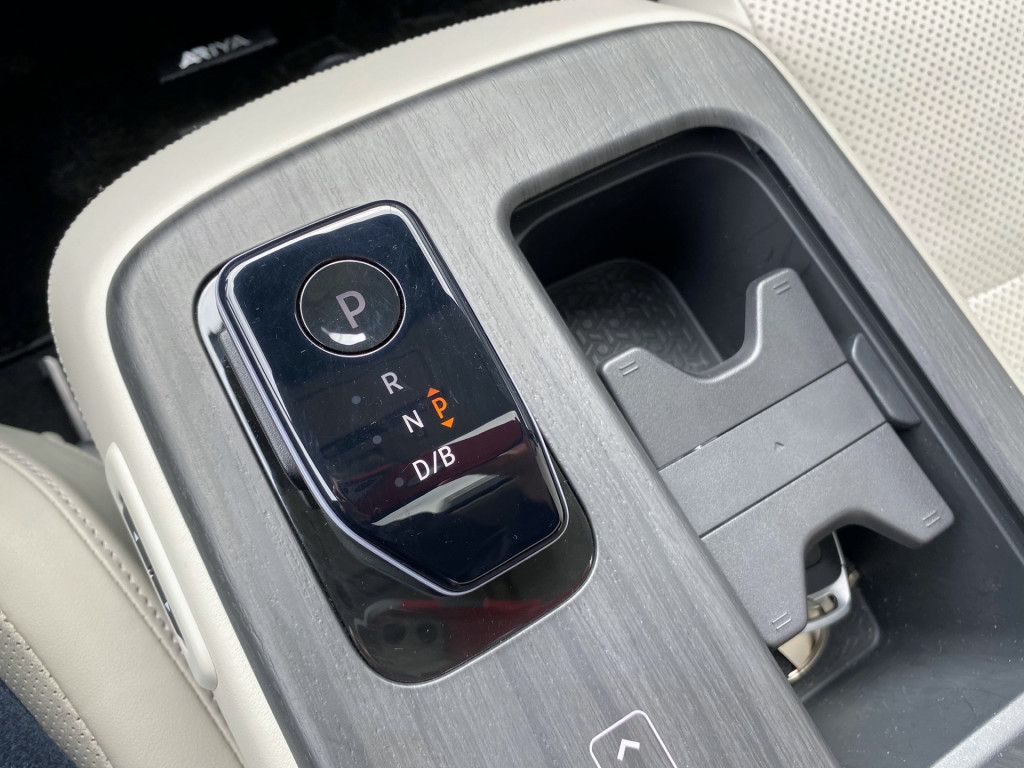
2023 Nissan Ariya (Euro spec) – preview drive
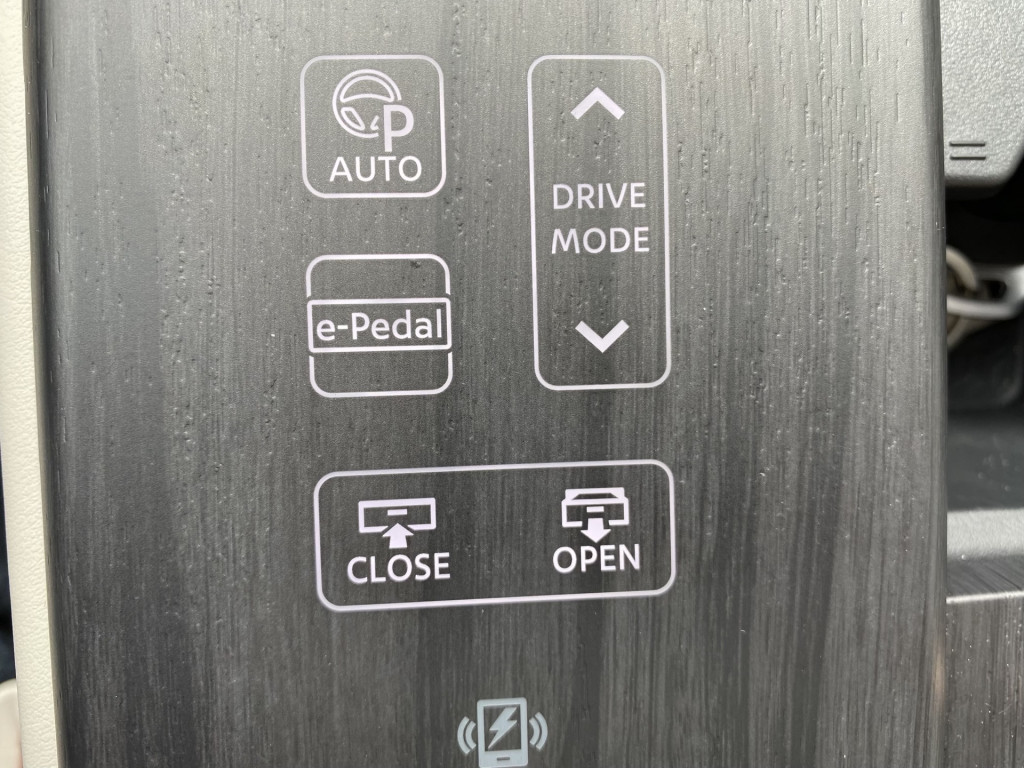
2023 Nissan Ariya (Euro spec) – preview drive
Much like the new Ioniq 5 and EV6, the Ariya includes dual 12.3-inch displays—one a touchscreen, the other a gauge cluster. The touchscreen is ready for wireless Apple CarPlay and wired Android Auto. It was hard to judge as it didn’t have connected services enabled; but given that, it responded very quickly and felt easy to navigate, with information assembled in either modules or standalone screens as warranted. Nissan visually separates the two screens with a clever curve that puts the gauge screen a bit farther away and in the driver’s field of focus. Senior VP for Global Product Planning Alfonso Albaisa called it a “Salvador Dali melted-clock bend.” It might look a little strange in pictures, but it makes perfect sense in person.
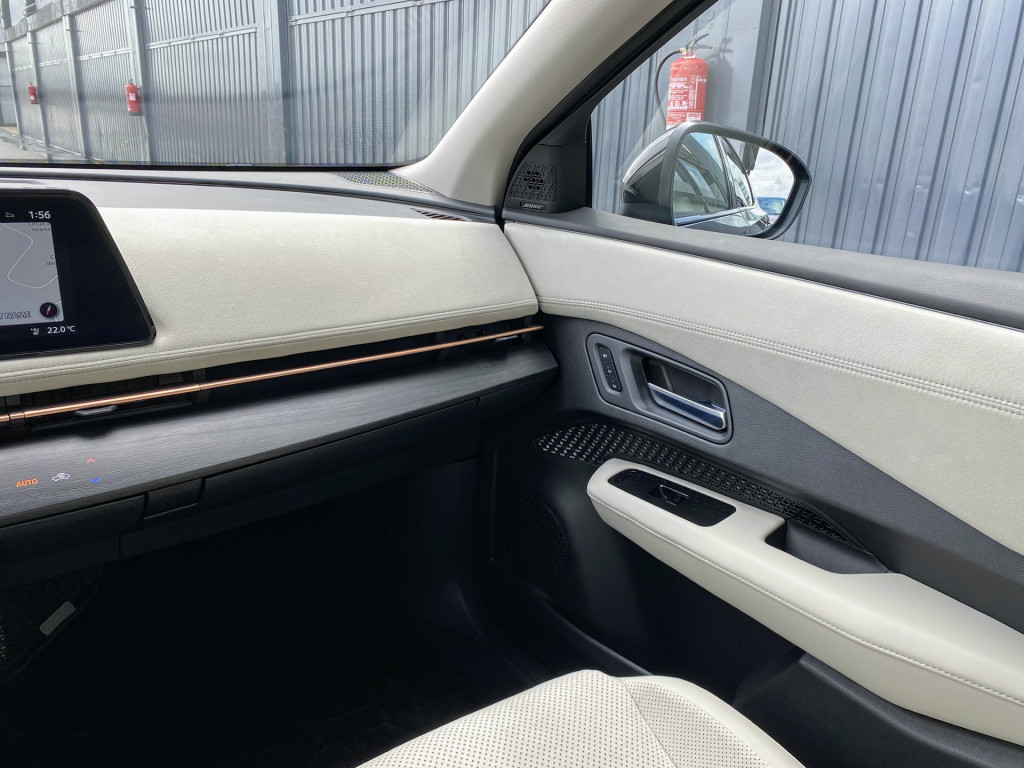
2023 Nissan Ariya – preview drive (Euro spec)
The version I drove, at roughly $55,000, was essentially a top-of-the-line Platinum+ in single-motor guise—with the available 20-inch alloy wheels, fine perforated leather upholstery, heated and cooled front seats, active sound control, a hands-free rear liftgate, and Bose 10-speaker audio.
Nissan says that with the smaller pack or the larger one, the Ariya will support DC fast-charging (CCS not CHAdeMO, another Leaf departure) at up to 130 kw—a bit lower than the 137 kw claimed at the model’s original reveal. Instead of going for a high peak charge power at a narrow state-of-charge window, Nissan claims to have tuned the Ariya’s thermal system to allow something close to that peak across much of the charge curve.
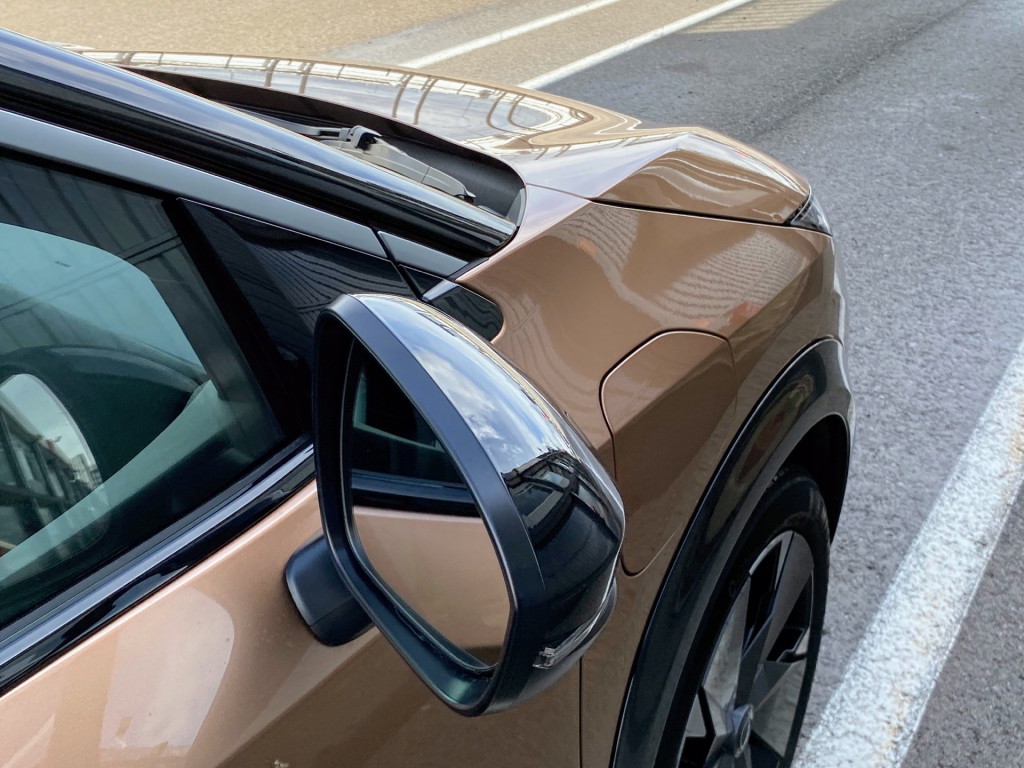
2023 Nissan Ariya – preview drive (Euro spec)
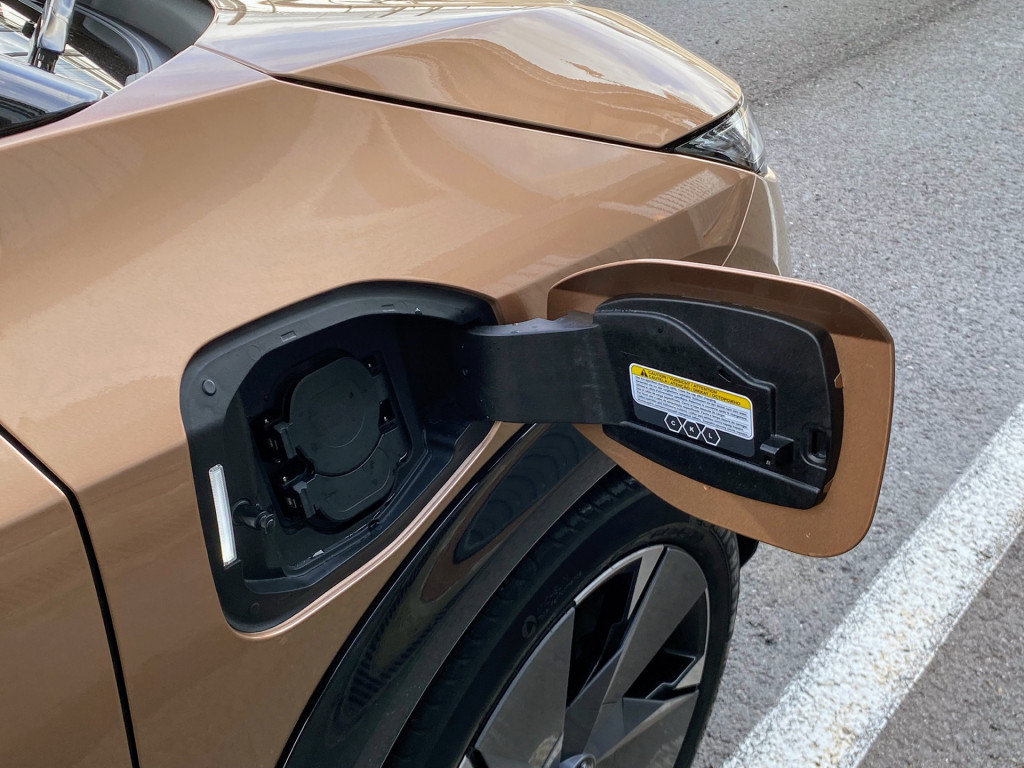
2023 Nissan Ariya – preview drive (Euro spec)
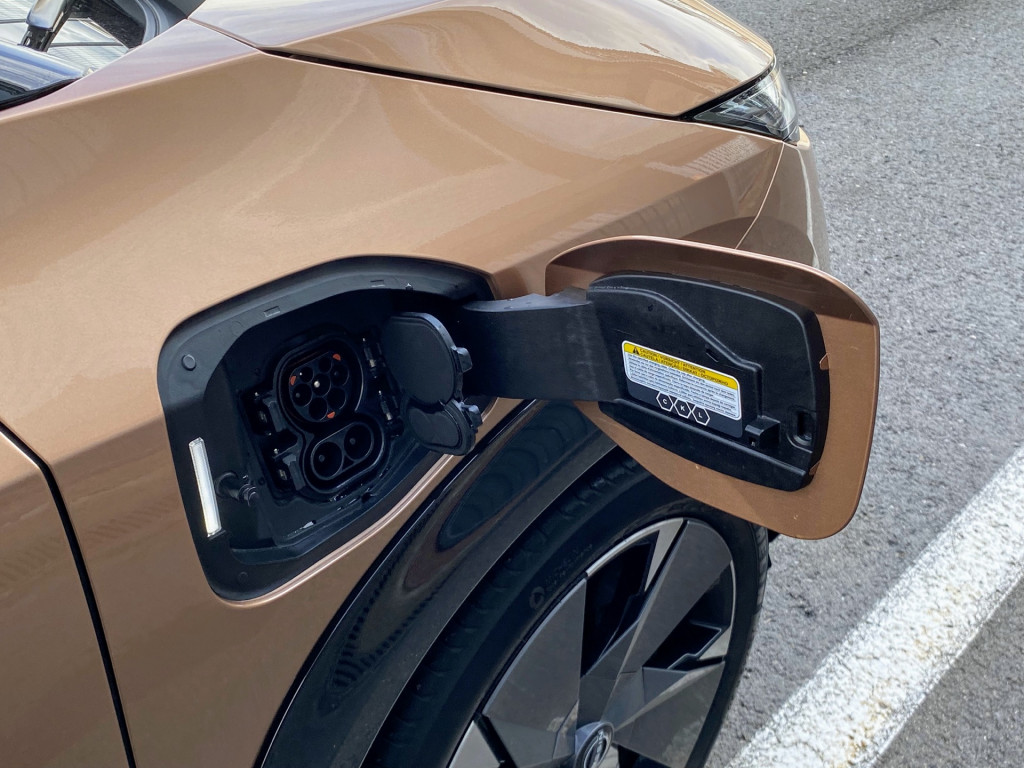
2023 Nissan Ariya – preview drive (Euro spec)
In my short drive, I left with no impression whatsoever of available range or charging rates or how e-4orce works in a production model (although I did get another drive in a \”super\” Leaf with the system, so we look forward to a full test toward the end of the summer. In the meantime, Nissan has said that the Ariya’s onboard charger will permit 240V Level 2 charging at 40 amps, with DC fast-charging stops potentially adding 175 miles in about 30 minutes. That’s definitely not in the same range as some other rivals, but hopefully it’s more predictable.
Nissan’s advantage: A decade of mass-market EVs
Nissan has a secret weapon that will help give it an advantage versus most of the other full-line automakers rolling out like-sized crossovers and ambitious EV plans: its dealership network. Over 11 years and around 175,000 U.S. sales, it has a grasp of how to support EVs effectively—and let\’s hope it can outperform its own goal of 40% EVs for the U.S. market by 2030.
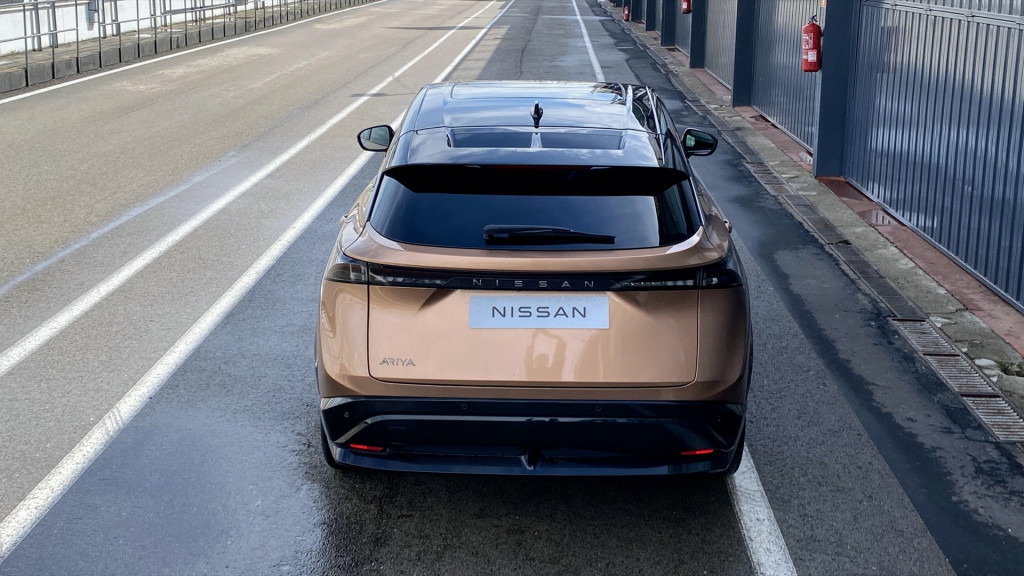
2023 Nissan Ariya – preview drive (Euro spec)
With the arrival of the Ariya, Nissan will have two different EV value points both starting under today’s average new-vehicle price. But with top e-4orce versions potentially offering an inside-and-out experience that transcends its forebear entirely, we’re glad Nissan has the perspective to build what are shaping up as some intriguing future EVs.
—
Internet Brands accepted travel and accommodations to facilitate product access for this firsthand report.









